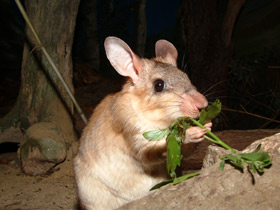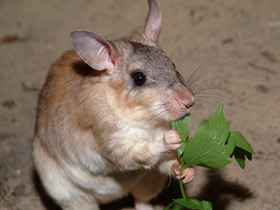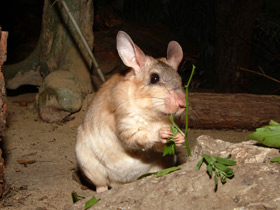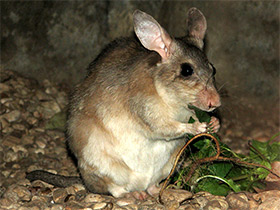The Malagasy giant rat (Hypogeomys antimena), votsotsa or votsovotsa
Malagasy giant rat видео
The Malagasy giant rat (Hypogeomys antimena), also known as the votsotsa or votsovotsa, is a nesomyid rodent found only in the Menabe region of Madagascar. It is an endangered species due to habitat loss, slow reproduction, and limited range (200 square kilometres north of Morondava, between the rivers Tomitsy and Tsiribihina) Pairs are monogamous and females bear only one or two young per year. It is the only extant species in the genus Hypogeomys; another species, Hypogeomys australis, is known from subfossil remains a few thousand years old.
Description, appearance and habits of Voalavo
Hypogeomys antimena reaches a length of 30 to 35 cm. Unlike the common hamster, its tail can be 21 to 25 cm long. Its fur is brown above and white below; the dark brown tail stands out against this. The Voalavo has greatly enlarged ears and hind legs, causing it to remotely resemble a rabbit. Interestingly, Hypogeomys antimena and occupies the same ecological niche as the wild rabbit on the island. The Voalavo has a limited distribution area - its range covers only 1,000 kilometres². It lives only in coastal humid jungles with sandy soil - they do not inhabit the mountainous terrain in the interior of the island. Hypogeomys antimena dig burrows up to 5 metres long, in which they spend daylight hours. At night they leave them and start to move by running or jumping. Animals feed mainly on fallen fruits, as well as shoots of grasses and trees, dig up rhizomes and bulbs. Hypogeomys antimena live in permanent monogamous pairs, and their broods usually have only one calf. Both parents are involved in caring for the offspring, and this care lasts much longer than in other rodents. Young males leave their parents at about 1 year of age, before the next breeding season begins, but females usually stay with the family for up to two years. The natural enemy of Hypogeomys antimena is Madagascar's largest predator, the fossa.
Habitat
Endemic to Madagascar, these animals are found in hard-to-reach areas of Madagascar's dry forests. Due to deforestation, they have become endangered. Hypogeomys antimena is listed as an endangered species on the Red List of the International Union for Conservation of Nature.
Reproduction and maturation
The male Malagasy giant rat reaches sexual maturity within one year, but will not mate until reaching 1.5 to two years of age. The female Malagasy giant rat reaches sexual maturity in two years. These rats are one of the few rodent species to practice sexual monogamy. Once mated, a pair will stay together until one of them dies. On the death of a mate, females tend to remain in the burrow until a new male is found. While males usually wait for a new mate as well, they do occasionally move to live with a widowed female. Females give birth to a single offspring after a gestation of 102–138 days (number observed in captivity) once or twice during the mating season, which coincides with the Madagascar rainy season from December to April. The young are raised by both parents, remaining in the family burrow for the first 4–6 weeks, then increasingly exploring and foraging outside. Young males stay with the family unit for one year before achieving sexual maturity and leaving to find their own burrow. Females do not mature for two years and remain with their parents for the extra year. Males are extremely protective of their young. They are known to increase their own predation risk to follow or defend their offspring.
Lifestyle and behavior
Completely nocturnal, the giant rats live in burrows up to 5 m (16 ft) across with as many as six entrances which, even those in regular use, are kept blocked by dirt and leaves to discourage predation by the Malagasy ground boa. The other main traditional predatory threat is the puma-like fossa but increasingly feral dogs and cats introduced to the island are hunting them as well. When foraging, the rats move on all fours, searching the forest floor for fallen fruit, nuts, seeds, and leaves. They have also been known to strip bark from trees and dig for roots and invertebrates. Pairs are highly territorial and the male and female will both defend their territory from other rats. They mark their territory with urine, feces, and scent gland secretions.
Conservation and efforts
The Malagasy giant rat is listed as critically endangered. Limited range, habitat destruction, increased predation by non-native feral dogs and cats, and disease have all led to the decline. Many feral cats also carry a parasite called toxoplasmosis which causes rodents to lose their fear of cats, to the point of almost being attracted to cats, resulting in their being caught and killed more easily. Hantavirus is another rodent disease ravaging the population, which causes kidney failure.
The Madagascan Government has enacted laws to protect the giant rat. Much of their territory is now the Kirindy Forest Reserve where sustainable forestry is practiced. The government has also introduced policies that help the inhabitants of the island coexist with the animals that live there. Gerald Durrell was the first scientist to breed the rats in captivity. In 1990, he brought five specimens to Jersey. Since then, 16 breeding programs have been set up and 12 have been successful.



















































